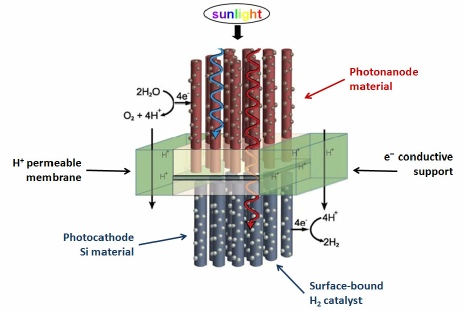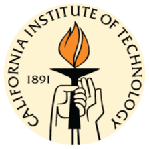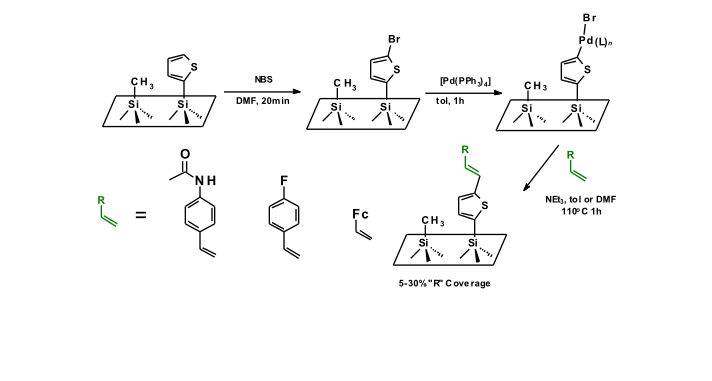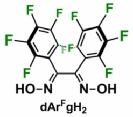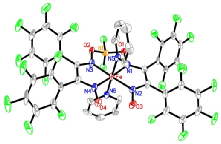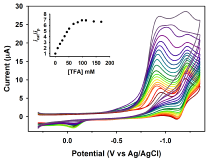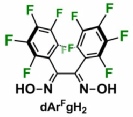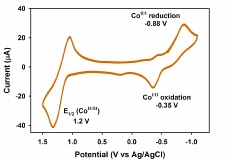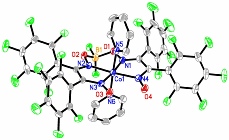Caltech Research Summary
My research here at Caltech as a joint postdoc between Prof Harry Gray and Prof Nate
Lewis has focused on the synthesis of novel hydrogen (H2) generating catalysts, and
their covalent attachment to silicon semiconductor surfaces. The work has been conducted
under the umbrella of the Chemical Center for Innovation - Solar Fuels (CCI-Solar),
also under the guidance of CCI-Solar PI’s Bruce Brunschwig (surface chemistry & characterization)
and Jay Winkler (kinetics & mechanism). This research project came about as a synergistic
result of the two research groups’ interests: Prof Gray has a longstanding interest
in the synthesis and electronic properties of novel late transition metal complexes,
and Prof Lewis has an established publication record in the electrochemistry of silicon
semiconductor liquid/solid junctions. So naturally, a joint position was ideal to
investigate the covalent attachment of small molecule catalysts to silicon surfaces.
Project #1: C-C Coupling Methodology on Passivated Si(111) Surfaces
The first challenge
in this project was to develop a robust means of making C-C bonds on a Si(111) surface.
Although there are some known strategies to covalently attach small molecules to
Si-R(111), these methods either lead to incomplete surface passivation (hydrosilylation)
or rely on semi-labile functional groups (amide, ester linkages) which are unlikely
to persist under the acidic aqueous conditions necessary for H2 generation. For this
reason we have developed a Pd-catalyzed Heck reaction to reliably make C-C bonds
on the Si(111) surface.
The primary means of characterizing the functionalized Si surfaces are X-ray Photoelectron
Spectroscopy (XPS); surface FTIR and HATR/GATR; and photo/electrochemical methods.
Publication (in preparation): L. E. O'Leary, M. J. Rose, T. X. Ding, E. Johansson,
B. S. Brunschwig
and N. S. Lewis. Heck Couplings of Small Molecules to Mixed Methyl/Thienyl
Monolayers at
Low Defect Density Si(111).
Project #2: H2-Generating Catalyst/Ligand Modification for Covalent Attachment to
Si(111)
The next logical step is to synthesize catalyst ligands bearing a pendant
olefin functional group to participate in the robust Pd-mediated C-C coupling. We
have derivatized a number of PNP, P2N2 and dmg (dimethylglyoxime) type ligands with
pendant olefins and are pursuing ligand attachement, metallation and electrochemical
characterization of the catalyst-functionalized surfaces.
The primary means of characterizing the ligands and complexes are the usual complement
of techniques of interest to the inorganic chemist: 1H/13C/31P/19F NMR, X-ray crystallography,
EPR, UV/vis, SQUID and electrochemistry.
Publication (in preparation): M. J. Rose, L. E. O’Leary, J. R. Lattimer, B. S. Brunschwig
and
N. S. Lewis. Covalent Attachment of Small Molecule Catalysts to Planar Si(111)
Semiconductor
Surfaces for Photoelectrochemical Hydrogen Generation.
Project #3: Perfluorinated
Diglyoxime Iron Complexes for H2 Electrocatalysis
One important challenge in H2 catalysis
is substitution of earth-abundant first-row transition metals for Platinum. Much
work has been done in recent years regarding several families of Cobalt and Nickel
molecular catalysts, motivated by the 1000x more abundant metals (and correspondingly
1000x cheaper). Ultimately, it is desirable to utilize the most abundant transition
metal - iron. Iron is of course present in all naturally occurring hydrogenase enzymes
(Fe-Fe, Ni-Fe and mono-Fe Hases).
We have synthesized a perfluorinated version of a diglyoxime ligand, which allows
for generation of H2 from iron complexes at moderate overpotentials (~-0.8 V vs SCE;
dmgBF2-Co system = -0.6 V vs SCE). This is a remarkable finding as, to date, all
small molecule Fe-Hase mimics operate at approximately ~-1.5 V vs SCE, a value far
too negative for coupling to a visible light-driven process.
Publication: M. J. Rose, H. B. Gray and J. R. Winkler. Electrocatalytic Dihydrogen
(H2)
Evolution at Low Overpotentials from Fluorinated Diglyoxime Iron Complexes. J.
Am. Chem. Soc. 2012, 134, 8310-8313.
Other Projects:
I have pursued several other projects related to the goals stated
above. The synthesis of novel Cobalt- and Nickel-Phosphine complexes has been of
particular interest:
Q. Dong, M. J. Rose, W.-Y. Wong and H. B. Gray. Dual Coordination Modes
of Ethylene Linked NP2 Ligands with Cobalt(II) and Nickel(II) Iodides.
Inorg. Chem. 2011, 50, 10213-10224.
M. J. Rose, D. E. Bellone and H. B. Gray. Structural, Magnetic and Spectroscopic
Characterization of a High-Spin Iodo Co(I) Complex Derived from a Tripodal Phosphine
Ligand. Submitted.

M. J. Rose, R. M. Mercado, B. S. Brunschwig, H. B. Gray. Electrocatalytic
Dihydrogen Evolution from Perfluorinated Cobalt Glyoximes in Aqueous Solution.
Work in progress.

